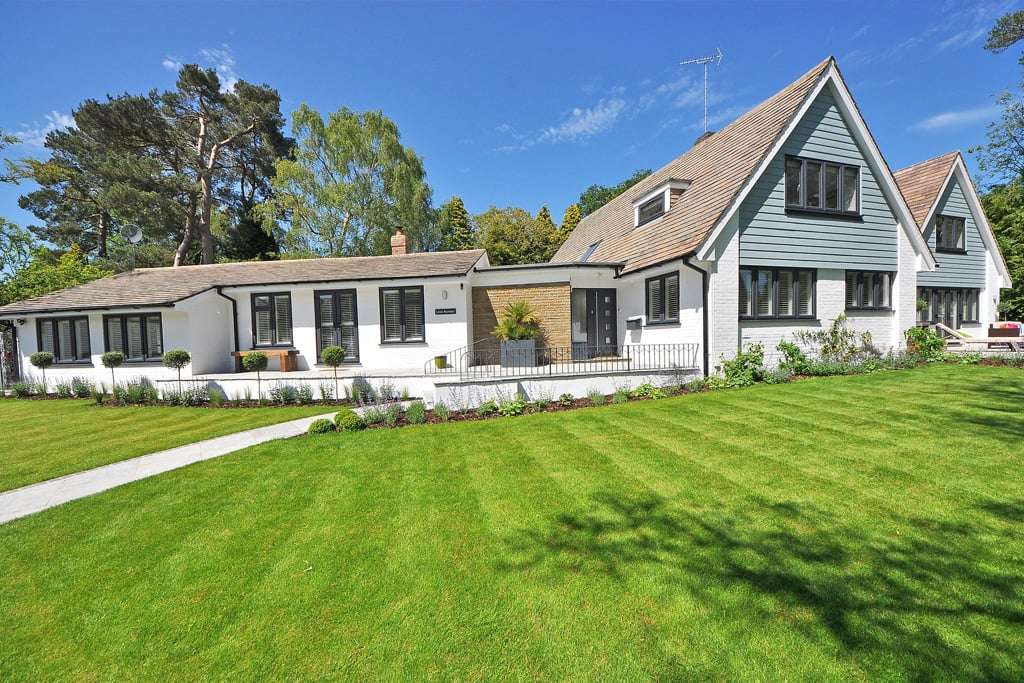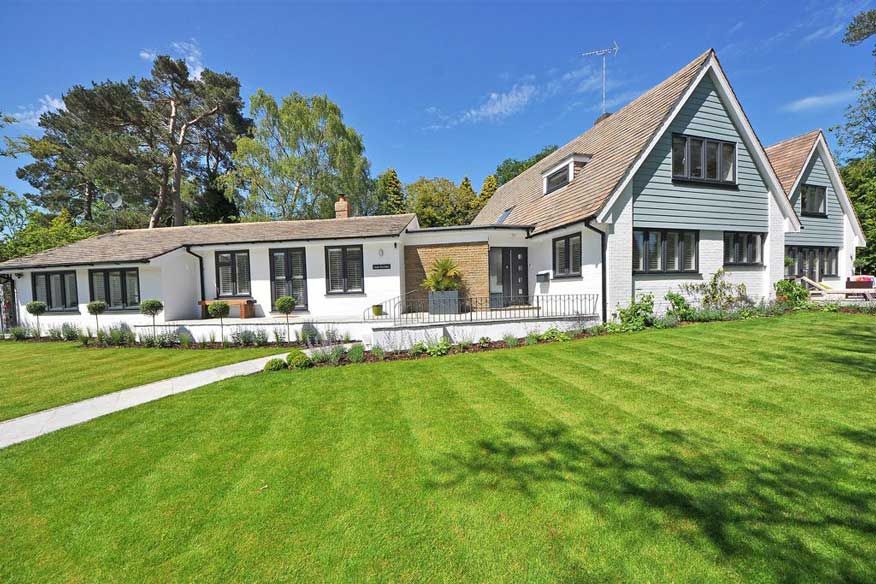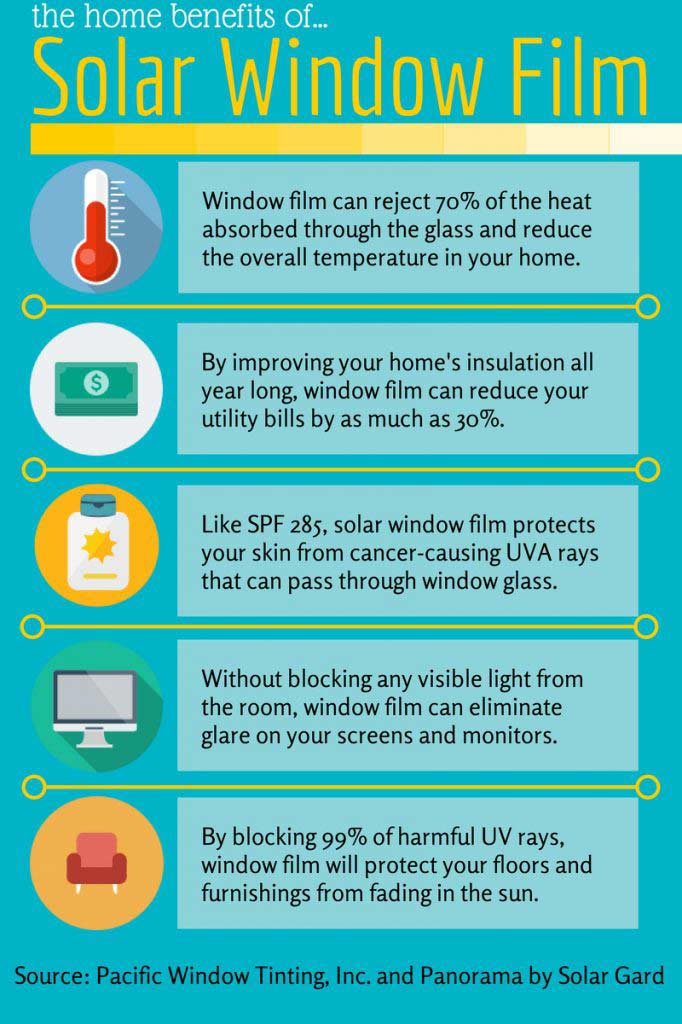Most floors see normal wear and tear over time due to foot traffic and years of use, but natural light is an additional factor that not every homeowner considers. If you’re in the market for eco-friendly flooring, you may be wondering if bamboo floors fade from sunlight exposure. Sunlight is a wonderfully warm and invigorating gift from nature that has many health benefits for human beings.
Despite its health benefits, sunlight can also cause damage to both skins and materials. Constant and direct sunlight (especially on southerly facing windows in the U.S.) is an undeniable force. It can fade almost any product in your home, including furniture, carpets, paint, electronics, plastics, and more.
Does Sunlight Cause Changes in Wood Floors?
Like any wood, bamboo flooring can also fade when exposed to direct sunlight for long periods of time. Even if you’re purchasing a bamboo floor with the UV protection layers included in our Accuseal Ultra Finish System, you still need to take steps to protect your beautiful new bamboo floor from the potentially damaging sunlight.
Direct sunlight can slightly fade or darken your floors over time due to the UV radiation in the sun’s rays. The extent of damage that will appear depends on several factors. One of those is the amount of sunlight that hits the floor. In sunnier states, particularly in summer, the effects will be stronger than during the winter of cooler states.
Another factor is the type of wood your floors are made of. Oak and cherry woods tend to get darker with aging as the UV light burns the wood. Other woods will lighten after extensive sunlight exposure. UV rays can also have a yellowing effect on hardwood and any protective film or finish added to it.
Sunlight, UV Rays, and Bamboo Hardwood Floors
The sun emits radiation. Photons stream from the Sun to our Earth in the form of ultraviolet light. These waves of energy are measured by the length of the distance between the wave peaks. There are three different lengths of ultraviolet light:
- UVA
- UVB
- UVC
UVA has the longest length waves, then comes to UVB and UVC. All UVC and most UVB waves are absorbed by the Earth’s atmosphere. Thanks for the assist atmosphere!
But the UVA and some of those UVB waves get through the atmosphere. These are the troublemakers that affect the chemical structure of the wood and change the wood’s color.
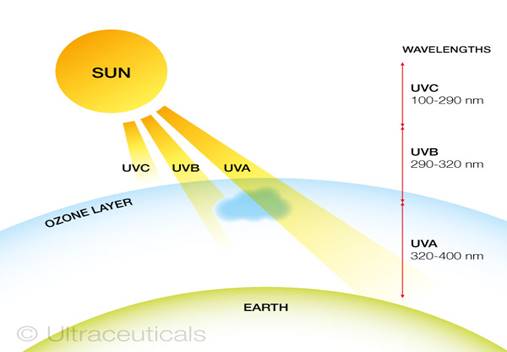
All hardwoods like bamboo are made up of carbon, hydrogen, and oxygen to create lignin and cellulose. Lignin makes plants rigid and woody. Cellulose is what makes plants stiff and upright. Researchers have discovered that ultraviolet light causes lignin to turn more yellow, and the more exposure the wood gets, the more the lignin is affected. Simultaneously, the UV radiation actually increases the amount of cellulose in the wood and creates free radicals. So, if you start with lots of lignin, the wood gets lighter. Otherwise, it gets darker.
When the Risk is Highest
The risk of sunlight damage to bamboo and other hardwood floors is highest when the UVA and UVB waves are the strongest. In North America, this is:
- Between 10:00 a.m. and 4:00 p.m.
- Spring and summer months (March to September)
- Latitudes are closer to the equator.
- Higher altitudes
- Sunny days
But that doesn’t mean the UV light coming through windows in a beach house on a cloudy day in Maine can’t damage the floors. It can.
Windows that face south get more light exposure than windows that face north. Any window shaded by a porch or an awning decreases the UV exposure as the light is deflected. So, what can you do?
How To Prevent Fading From Sunlight On Hardwood and Bamboo Flooring
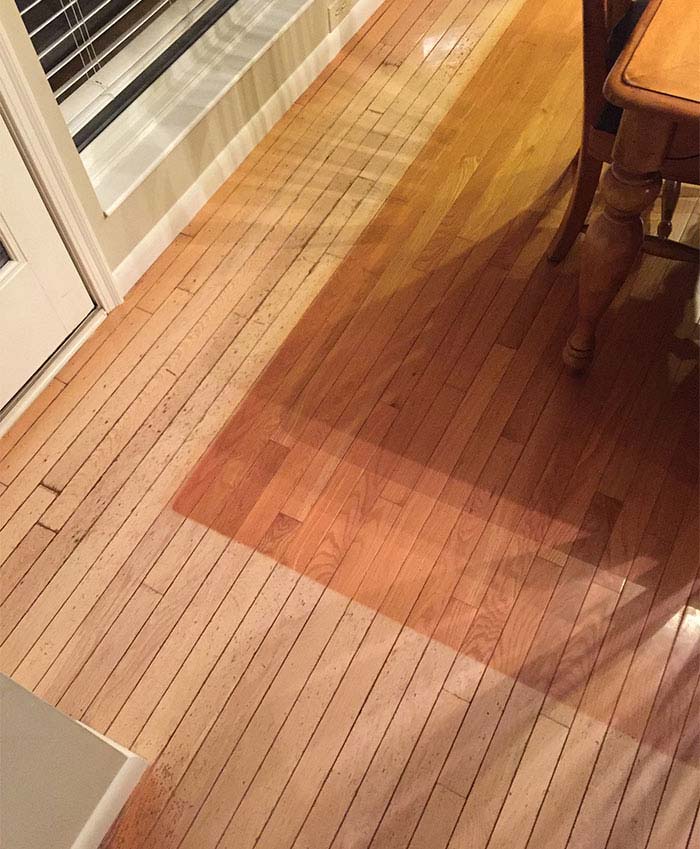
Tip #1: Purchase Bamboo Flooring with UV Protection
The best offense is a good defense. That works in more than sports.
Start by purchasing bamboo flooring with protection like the Accuseal® Ultra protective flooring finish. A multi-layered system like this will give you water and scratch resistance protection and some UV light protection. It’s like a layer of SPF 10 on the wood.
But you can’t stay in the sun all day with SPF 10 and not get burned. Likewise, you can’t expect the manufacturer’s flooring finish to provide all the UV light protection you need, no matter how awesome it is. So, you’ve got to do a few other things.
Tip #2: Periodically Move Furniture
Once again, the best offense is a good defense.
Rearrange the furniture so that different portions of the floor are exposed to UV light, and the shade of the furniture protects different portions. Keep in mind that the light comes in different windows depending on the time of the day.
Furniture sliders make this job easier than you think. Keep the sliders under the feet of your heavier pieces of furniture at all times, and when it’s time to Feng Shui the furniture, they’ll glide much more easily. Sliders make moving furniture so easy you may even do it more often.
More than your floors will thank you for this. Upholstered couches and chairs, lamps, and coffee tables will appreciate getting a break from their sunbathing routine. Rugs will also welcome a field trip to another part of the room or house. Speaking of rugs…..
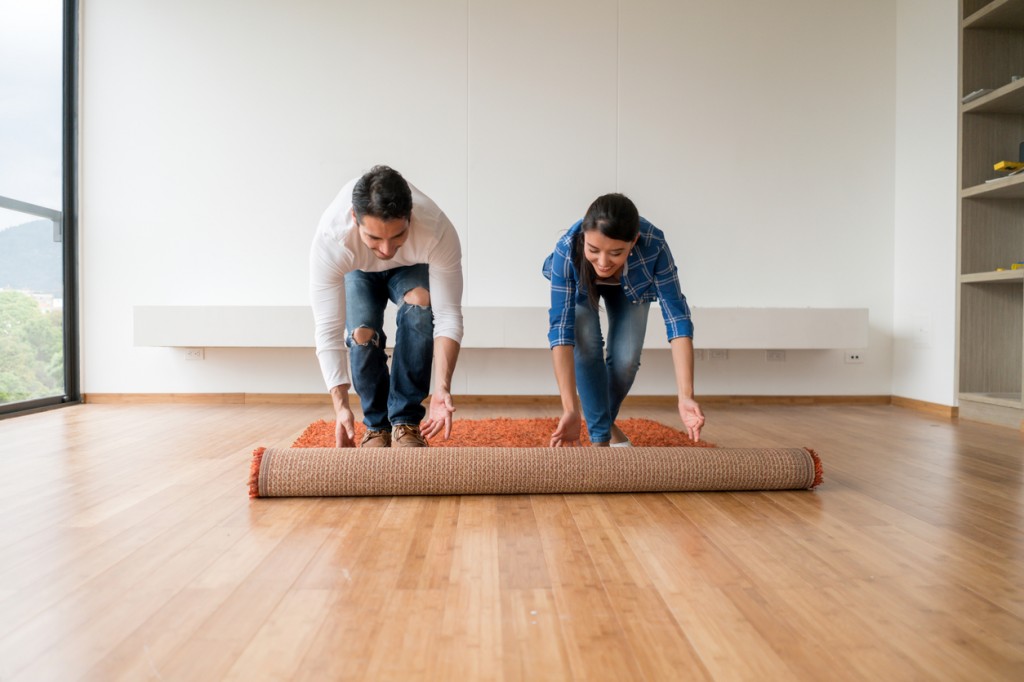
Tip #3: Select Rug Mats that Won’t Mar the Floor
Coconut coir and jute are awesome for scraping that dirt and mud off the bottom of your shoes. They are perfect outside the door. But when it comes to inside the house, use rugs and mats with a natural rubber backing.
Sure, hardwoods are “hard,” but that doesn’t mean that the grinding action created when people walk on a rug won’t scratch the finish.
Protect your floors from your rugs and runners with pads made from rubber. Better yet, get a rug or runner with a natural rubber backing.
Rubber grips better than PVC-based pads and backing, so it puts the brakes on sliding. PVC can also stick to the wood and mar the surface where natural rubber does not. Marring the finish isn’t exactly the performance you desire in a product put down for protection.
Tip #4: Cover Your Windows to Keep UV Out
The easiest solution is to keep the harmful UV rays out, to begin with. You can do that with:
- Curtains and draperies
- Blinds, shutters, and shades
- Window film
- Windows with Low-E glass
Curtains and Draperies
Nothing makes a room look finished like a set of draperies or curtains. They are essential in setting the style and feel of the space. Whether you go with drapes or curtains, you’ll get some level of UV protection. From blackouts to sheers, the amount of protection you get depends on the fabric and density.
Here a designer from Eclipse Curtains describes the technology’s differences to block light and UV radiation.
By the way, did you know there is a difference between curtains and drapes? Well, there is. Drapes and draperies are panels of fabric with a lining. They are pleated at the top of the panel and hang to the desired length from a rod. Think of them as black-tie attire for your windows.
Curtains are ready-to-wear panels of fabric that don’t have a lining. Because they aren’t lined, they are thinner and lighter than most drapes. They also hang from rods and can cover the entire window or just a portion. You can even pair curtains with blinds for a double layer of UV protection.
Blinds, Shutters, and Shades
Good news! The same blinds, shutters, and shades you use for decor also block harmful UV radiation. Blinds have horizontal or vertical slats. Shades are made of fabric or fabric-like material. Blinds and shades install at the top of the inside of the window. Shutters are blinds that install on the window frame. When it comes to blinds, shutters, and shades, you have almost as many options as drapes and curtains. This includes:
- Vertical blinds
- Plantation shutters
- Horizontal blinds
- Roman shades
- Venetian blinds
You can even buy doors with the blinds or shades already installed between the panes of glass.
Window Film
Window film reduces UV light and insulates as well. There’s DIY window film, or you can hire a professional.
Window film is a thin coating that is applied to the windows. It stops the UV radiation without stopping the light. That makes it a great option if you want to keep using natural sunlight to create an eco-friendly indoor sanctuary without fading your floors or furniture.
Like other window coverings, this can also help keep your room cool in summer. So, not only are you saving your floors and furniture, you’re using less energy and saving the planet too. Go you!
Windows with Low-E Glass
If it’s time to replace the windows in your home, investigate windows with Low-E glass.
Major window manufacturers create Low-E glass by applying glazing to the inner or outer panes of the glass.
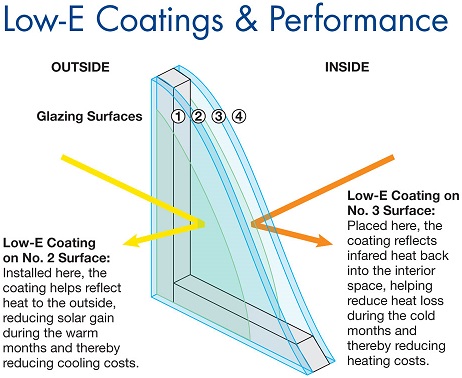
Window manufacturers measure the performance of their Low-E windows with:
- U-value: This measures the heat loss from a u-value of a window indicates heat loss. Look for a low number.
- Solar Heat Gain Coefficient: This tells you how much solar heat is transmitted through the window. This is another number you want to below.
- Visible Light Transmittance: The measure of the amount of sunlight coming through the window. You must balance this number against the other two numbers. What good is a window if it doesn’t allow any light through?
Low-e windows will cost a bit more (10% -15%) upfront. But, over the life of the window, it’s going to save you much more. Savings come from:
- Reduced energy costs for heating
- Reduced energy costs for cooling
- UV damage to upholstered furniture and another fabric-based décor
- UV damage to bamboo flooring, hardwood flooring, or carpet.
So, keep this option in mind next time you shop for windows.
Bamboo Flooring and Sunlight Summary
Sunlight from doors and windows causes bamboo and another hardwood flooring to change color. Depending on the wood, UV light can make the wood lighter or darker.
Sunlight also damages wood flooring over time.
This discoloration and damage aren’t attractive and must be prevented. But you don’t want to live in a dark house (unless, of course, you are a vampire)
Thwart the damage by:
- Purchasing flooring with UV protection
- Periodically moving furniture
- Using window coverings like blinds, shades, shutters, drapes, and curtains
- Installing window film to reduce UV light
- Use windows with Low-E glass to replace existing windows.
Also, keep in mind when the UV light is the strongest, and use your window coverings during these periods.
Do you carry out any special measures to help protect your bamboo floors? Have you invested in any of the protective products listed above? Share your top tips for protecting flooring from sunlight exposure in the comments box below.

About the Author
Jen is your go-to guru for crafting a cozy, green cocoon. 🪴 Her dive into sustainable building wasn’t just about saving the planet—it started as a mission to make family movie nights eco-friendly (and to ensure the popcorn was the only thing getting heated!). With a knack for breaking down the jargon, Jen turns eco-lingo into everyday language. Swing by the Green Living blog for a mix of earth-loving advice and home improvement hacks. Whether you’re just dipping your toes into green waters or you’ve been swimming in the deep end of DIY projects, Jen’s here to guide, giggle, and remind you that every eco-choice is a step towards a planet that thanks you… and maybe even sends a rainbow your way! 🌈

